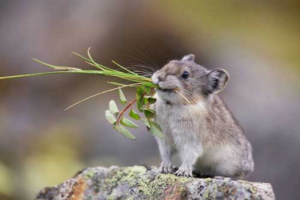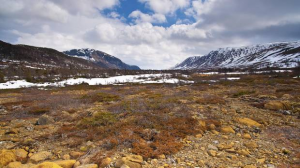
It is often easy to ignore the effects of climate change when those effects don’t have a direct impact on your immediate surroundings. However, if you take a closer look at the more northern habitats, you will see how climate change is affecting both the local tundra ecosystems and the animals who call that area home. One such animal is the collared pika – a mammal that resembles a small bunny and is part of the same order as rabbits (Lagomorpha). The effect that climate change is having on this mammal is currently being studied by University of Alberta researchers David Hik and Scott Williamson.
David Hik’s research emphasizes plant-herbivore-climate interactions in northern alpine and tundra ecosystems, while Scott Williamson is involved in research on elevation dependent warming (4). Scott Williamson’s research contributions on elevation-dependent warming were published in the journal Nature Climate Change in April, 2015
http://www.nature.com/nclimate/journal/v5/n5/full/nclimate2563.html

The collared pika is a species of pika that lives in the more extreme northern climates. They have adapted to this colder climate through a combination of different behavoiurs. They burrow under thick snow packs in the winter, which allows them to survive these colder months since they don’t hibernate (2). Collared pikas also gather food in the summer months and store it in a separate pantry or “cache” over the winter (2). In the summer, they hide from predators and shield themselves from the heat in rock “talus” sites at the base of landslides (3).
The food that they gather and store, mostly consists of green grasses and the leaves of alpine meadow plants (2). However, a combination of lower temperatures and other global warming trends is negatively affecting their food supply and ability to shelter themselves from the cold in snow packs. This is a concern considering that their populations are already dropping by 90% over the winter months, as observed by David Hik (2).
Northern habitats are currently being affected by the global warming trend of “shrubification,” which is having an impact on the survival of collared pikas. Shrubification is the colloquial term that describes the process of shrub expansion into more northern areas and at higher altitudes. These shrubs are able to expand farther north due to factors such as lower temperatures, soil disturbances and herbivory (1). For example, reduced temperatures allow for enhanced soil nutrient uptake. Landscape and soil disturbances also contribute to increased shrub abundance and distribution. Grazing herbivores have an impact on shrub distribution by altering seed production and seedbed size, transport of seeds and soil fertilization (1).

This process of shrubification is causing the already endangered collared pika populations to dwindle further due to decreasing their food sources and reducing the snow pack cover.
The advancement and canopy thickening of shrubs is causing a reduction in albedo (or, sun reflectance off snow), which contributes to warmer temperatures. It also takes longer for the snow to melt under shrubs, which then covers the meadow plant seedlings for a longer time and delays the growing season (2).
In combination with this, the lower temperatures are also causing more rain and ice and less snow. This then leads to reduced snow pack thickness, and when the rain freezes, it covers any winter vegetation with an impenetrable shell of ice (2). Therefore, the collared pikas face many challenges in their alpine habitats.

To help these creatures, make sure that you are doing all that you can, such as driving less, recycling, drinking water from reusable bottles and reducing your overall energy consumption. These fluffly little bunny-like creatures will surely thank you!
References:
1. Myers-Smith, I. H., Forbes, B. C., Wilmking, M., & Hik, D. S. (2011, December 20). Shrub expansion in tundra ecosystems: Dynamics, impacts and research priorities. Environ. Res. Lett., 6. http://iopscience.iop.org/article/10.1088/1748-9326/6/4/045509/meta
2. Pratt, S. (2016, Spring). Swim or Sink. New Trail (University of Alberta Alumni Magazine), 16-28.
3. https://en.wikipedia.org/wiki/Collared_pika
4. https://www.ualberta.ca/science/about-us/contact-us/faculty-directory/david-hik
7. http://esseacourses.strategies.org/module.php?module_id=99
Find me on Twitter: @jacbird and @masitblog




















